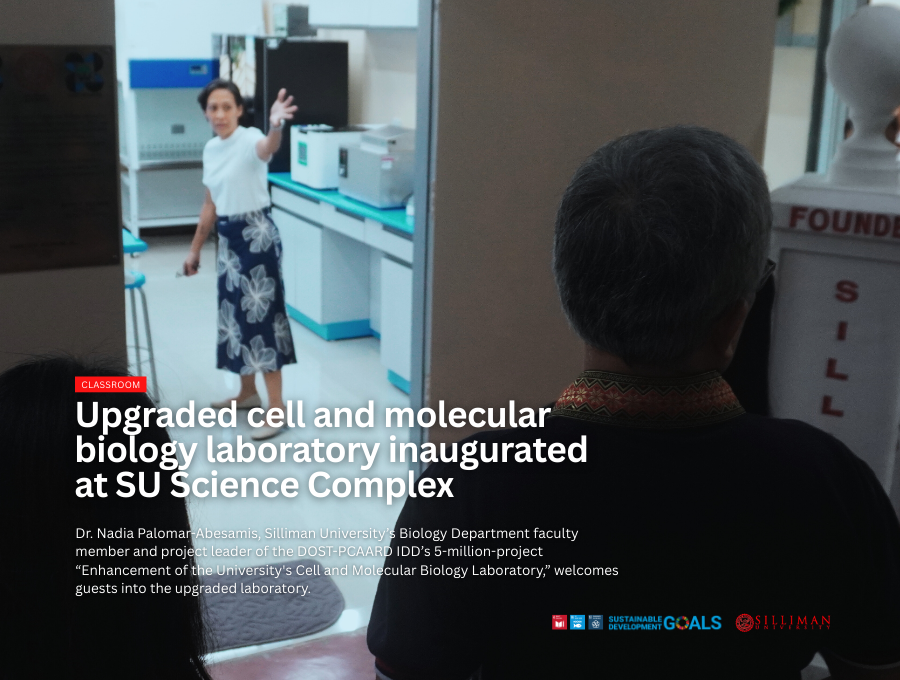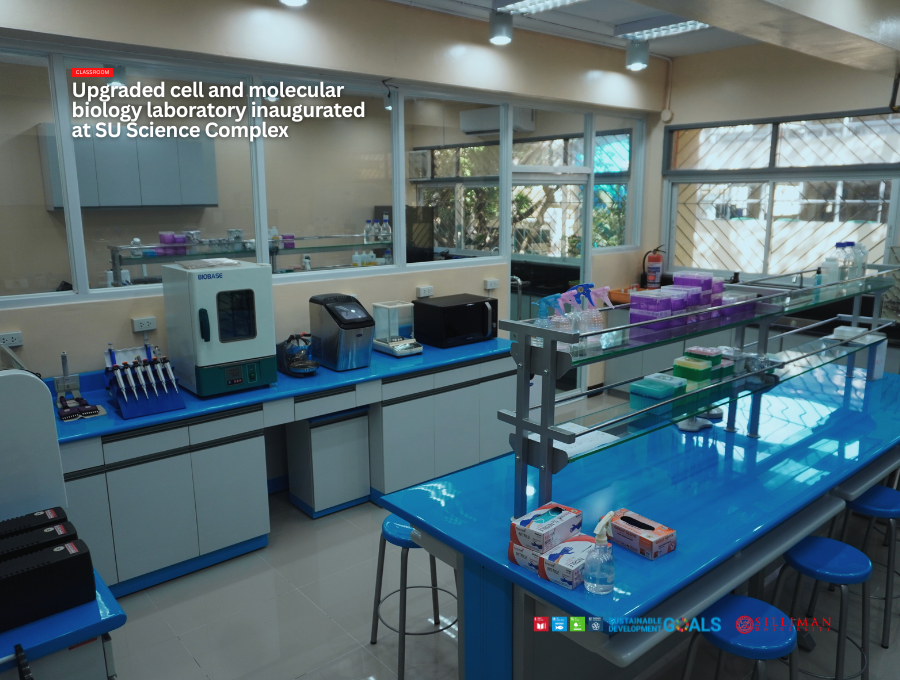
Upgraded cell and molecular biology laboratory inaugurated at SU Science Complex

Carrying a renewed commitment to scientific advancement and biodiversity conservation in the region, the Silliman University (SU) College of Arts and Sciences (CAS) Biology Department, under the leadership of Assoc. Prof. Michael Lawton R. Alcala, formally inaugurated its upgraded Cell and Molecular Biology Laboratory on November 20, 2025, marking a major milestone in the university’s expanding research capabilities.
The event gathered representatives from key partner agencies and institutions, including Engr. Wilmar J. Lastimosa, Victor P. Alcantara, Sherwin R. De Los Reyes, and Rudolph John M. Cabangbang of the Department of Sciences and Technology-Philippine Council for Agriculture, Aquatic and Natural Resources Research and Development Institution Development Division (DOST-PCAARRD IDD); Dr. Dalisay E. Cabral and Dr. Christine D. Santiago of DOST-PCAARRD Forestry and Environment Research Division (FERD); Mr. Dionisio P. Babiera of the Department of Environment and Natural Resources-Provincial Environment and Natural Resources Office (DENR-PENRO); Dr. Lourdes Y. Fabro of Foundation University; Dr. Kent E. Carpenter of Old Dominion University; and Matt Ward of the Talarak Foundation.
A vision realized
Dr. Nadia Palomar-Abesamis, Biology Department faculty member and DOST-PCAARD IDD-funded project leader described the upgraded laboratory as the “fruition of what started off as simple aspirations.”
She recalled how the project began with modest needs, “one more PCR, maybe one more micropipette,” that eventually transformed into a larger vision fueled by persistence and strong partnerships.

The department’s former 24.5-square-meter room has now been replaced by a modern 72-square-meter facility equipped for advanced molecular work, offering a space that can comfortably support more researchers and more sophisticated scientific methods.
Abesamis highlighted how a single email from a Filipino scientist abroad years earlier set in motion a series of “fortunate events” that helped secure research funding and eventually a multimillion-peso grant for laboratory enhancement.
“These outcomes were brought about because of the commitment of our faculty, the support of our staff and university, and the encouragement of our collaborators,” she said. Abesamis emphasized that the laboratory is envisioned to serve not only the department but also other institutions in the province and region.

Abesamis (center right) from SU and Lastimosa (center left) from DOST-PCAARD IDD lead the cutting of the ribbon to formally inaugurate the laboratory.
Strengthened support from DOST-PCAARRD
Engr. Wilmar Lastimosa of DOST-PCAARRD IDD underscored the agency’s strong commitment to enabling research institutions through facility improvement and human resource development.

Engr. Wilmar J. Lastimosa of DOST-PCAARRD IDD speaks to the audience at the event.
He noted that the 5 million-project, Enhancement of the University’s Cell and Molecular Biology Laboratory, is the first PCAARRD-supported facility improvement initiative at the university and is expected to bolster wildlife conservation efforts in the province.
He expressed confidence that the upgraded laboratory, along with complementary PCAARRD programs, will contribute significantly to the region’s biodiversity preservation goals.
“The challenges encountered only strengthened the dedication of everyone involved,” he said.

Dr. Dalisay E. Cabral of DOST-PCAARRD FERD affirms her division’s commitment to SU’s projects.
Meanwhile, Dr. Dalisay E. Cabral, from DOST-PCAARRD FERD, emphasized the laboratory’s role as a symbol of scientific excellence and strong partnerships. She highlighted the ongoing research on genetic diversity and conservation of endemic and endangered species, noting that the upgraded facility enables higher-quality molecular work crucial for these studies.
“The technologies and environment established here will support wider research and development efforts—from wildlife genetics to biodiversity conservation,” she said.
She reaffirmed PCAARRD’s commitment to continue supporting the university’s growing role in national scientific innovation.
A center for international research

Dr. Kent E. Carpenter of Old Dominion University expresses his excitement to be doing his future research at SU’s laboratory.
Providing historical context, Dr. Kent Carpenter of Old Dominion University shared his long-standing collaboration with the university, dating back to 1976. He described the new facility as a “force multiplier” that expands opportunities for international scientific partnerships.
Carpenter emphasized that the upgraded lab will boost ongoing and future research projects, many supported by the U.S. National Science Foundation.
He also expressed intent to help source additional equipment to further strengthen the laboratory’s capacity. “I have a lot more science I want to do in the Philippines—and this is where I want to do it,” he said.

Dr. Robert S. Guino-o II shows a picture of the very first DNA barcode generated by the laboratory, which was of a frigate tuna.
Dr. Robert S. Guino-o II, executive director for Research, Publication, and Innovation (RPI) and concurrent SU Angelo King Center for Research and Environmental Management (SUAKCREM) director, noted significant milestones since the laboratory began its operations.
“The new laboratory commenced its operations with DNA barcoding, microsatellite amplification, and MCH gene characterization, starting August 27, 2024, to the present,” he explained.
According to him, the laboratory’s first research output was the 2021 publication “DNA Barcoding of Philippine Freshwater Eels of the Families Anguillidae and Synbranchidae” by Melgar, Guino-o, and Sienes. Its second publication followed in 2024 with “Morphology and Molecular Analysis of Western Pacific Crown of Thorns Starfish” authored by Labnao, Sienes, and Abesamis.
Guino-o also reminded everyone “not to rest on any laurels.”
“We need to continually put our acts together by building our research and development (R&D) capacity through collaboration with other R&D facilities, upgrading laboratories at Silliman University, hiring young faculty, and sending them for PhD studies,” he said.

Silliman University Biology Department faculty members, led by Assoc. Prof. Michael Lawton R. Alcala (second from right), chair, poses with members of DOST-PCAARD IDD and FERD outside the laboratory. Behind them is the plaque from DOST signifying both institutions’partnership and the project.


